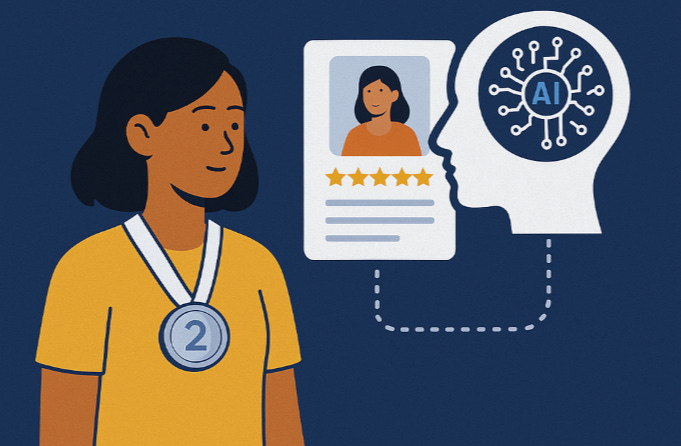How AI Can Build a Real Recruiting Culture: “Silver Medalists” Deserve Better
AI can turn overlooked 'silver medalists' into future hires, creating a recruiting culture that values people, not just positions.
We hire one great person and quietly lose four more. If that sounds familiar, you’re not alone. In 2024, 61% of job seekers said they’d been ghosted after an interview (via Greenhouse); a jump from earlier in the year. That’s not just a bad look; it’s a workflow problem. We spend serious time and money to meet outstanding people, then let them drift into the ATS void.
Here’s my contrarian view after seven years in HR and talent tech: AI won’t replace recruiters. It will finally make it practical to behave like the culture we always claim to have. A culture where every qualified candidate (especially the ones who finished second, third, or fourth) get closure, context, and a path back in. Where we turn the ‘almost hired’ into ‘advocates’.
How I’ve seen it: we ignore tomorrow’s hires today
Most organizations still recruit reactively. HR.com’s 2025 outlook found over 50% rely on just-in-time hiring, not proactive workforce planning. Translation: we sprint only when a seat is empty, then forget everyone who almost made it.
That amnesia is expensive. I hear most companies talk about a cost to hire between $3k and $5k with a time to hire between 1-2 months; which is long enough to lose great people to faster competitors. Every time we reopen a job from scratch, we instantly pay the cost and restart the clock.
Worse, the recruiting experience gap is widening. I think it’s pretty obvious that candidates are resenting the recruiting process-of-new, but just in case, here's a report from over 230,000 candidates surveyed made by ERE. The candidate-experience shows resentment hitting new highs when feedback and closure go missing. If your “top five” only ever hears from you once, when you send a rejection, you’re telling next year’s finalists exactly how it’s going to feel (and they don’t forget).
Why are we not taking those same, qualified finalists into a sub-process or pool? They can be your fastest future hires when AI finds and re-engages them without drowning in manual work.
What AI changes (and what it doesn’t)
AI doesn’t magically make bad processes good. But it does make good behavior scalable. Three shifts matter:
Rediscovery on demand. Instead of fishing for keywords, AI can parse prior applications, interview notes, and data to surface “silver medal winners” the moment a similar role opens. When you lean into this, time-to-fill drops fast.
Personalized re-engagement, without the copy/paste lifestyle. A respectful, context-aware nudge is night-and-day from a generic blast: “We loved your systems design deep dive in March; a Staff role just opened that leans even more on that skill. Interested?” This is only feasible with AI since it remembers what made a candidate compelling in the first place; transparent communication measurably improves sentiment.
Decisions, not admin. Summarized feedback, structured scorecards, clean pass-through data; AI helps hiring managers decide instead of wade through noise. That alone shortens cycles and raises the bar.
Signals you have a “runner-up” problem (and a culture gap)
Final rounds produce multiple “strong yes” candidates, yet no systematic re-contact within 6–12 months.
Your fastest hires almost never come from past finalists; most new slates start cold.
Rejection notes are generic, slow, or absent; referrals from rejected finalists are rare.
Finalists should be treated like alumni, not strangers, and Mega makes that mindset on autopilot: close the loop within five business days with a short note (why the other person edged it, where they shined, what roles you’ll consider them for next), segment intelligently by competency / level / interview signals so near-hires get first look on similar openings, and re-qualify lightly with a two-minute update on interest, location, comp band, and new work. Do this consistently and your funnel changes shape. Get more hires from people who already know (and still like) your brand, faster cycles, and a cost-per-hire.
A simple 90-day playbook
Weeks 1–2: Institute a “100% closure” promise and SLA (rejections within 5 business days). Create a label for finalists (e.g., Final-Round-Qualified) and capture the why in notes.
Weeks 3–6: Run an AI rediscovery sweep for your 10 most common roles (past 24 months). Prioritize segments with positive panel feedback and near-fit level mismatches.
Weeks 7–12: Launch two respectful re-engagement cadences per department personalized open → context follow-up → referral ask. Track replies and interviews started from this pool.
What about the broader funnel?
You’ll still advertise, source, and run structured interviews. The difference is what happens after. With AI doing the heavy lifting; finding past near-hires, drafting thoughtful updates, and teeing up clean comparisons. Recruiters and hiring managers can focus on what actually builds culture: speed, respect, and clarity. That’s how you turn a rejection today into a “yes” tomorrow.
Make it measurable and fair
If you can’t see it, you can’t scale it. Pick a small set of metrics and review them weekly with your hiring leaders. Hold yourselves to human standards and legal ones.
Rediscovery hires as % of total hires. Getting this above 10% is a great start plus your time to hire could be cut in half.
Time-to-slate. Getting a qualified shortlist under 7 business days for common roles.
Re-engagement reply rate (finalists). A healthy range between 20–40% is great and multiples higher than cold outreach.
The irony of this article is palpable, but what I’ve shared is tough to deny. The same technology many blame for turning hiring into an arms race is what makes it realistic to act like a company candidates want to ‘work with’. Start with the four finalists you didn’t hire. Treat them like future teammates. Use Mega HR to keep the promise; we’ll leave the rest of your culture up to you.


